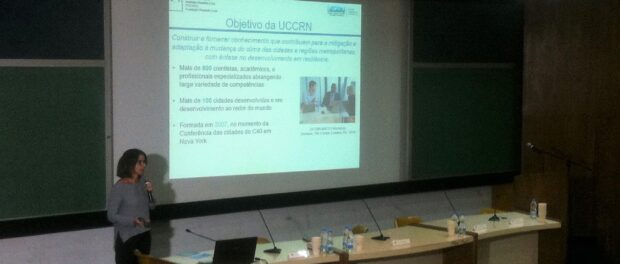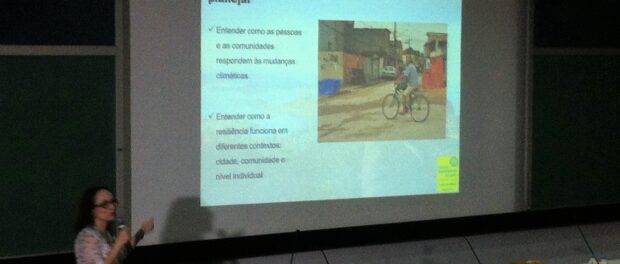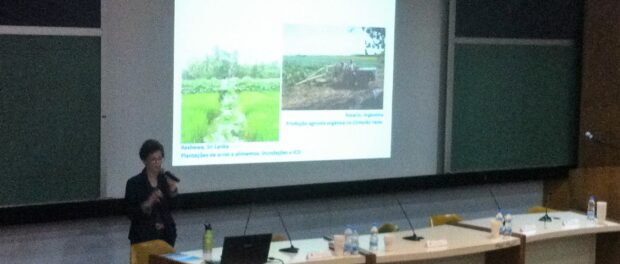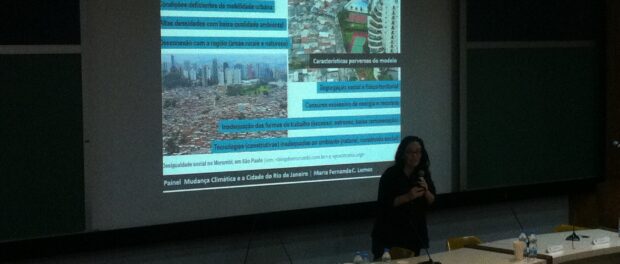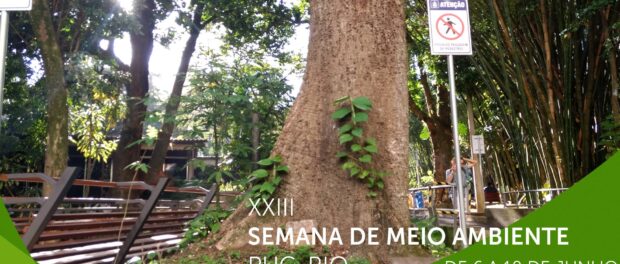
The XXI Pontifical Catholic University of Rio (PUC-Rio) Environment Week took place last week from June 6-10, 2017, which is organized by the university’s Interdisciplinary Nucleus for the Environment. All activities were open to the public, with rounds of lectures, debates, and workshops on the topic of sustainability. Volunteers and ecological organizations participated in the event, which helped organize and promote the activities.
The panel that wound up Environment Week was on the topic of Climate Change and the City of Rio de Janeiro, held in partnership with Virada Sustentável Rio de Janeiro (Sustainable Turnaround Rio de Janeiro), a program that promotes environmental mobilization and organizes the largest festival on the subject in Brazil. The dialogue highlighted the impacts on the cities in terms of various issues, which, although of extreme relevance now and in the future, remain for the most part unexplored in the daily lives of citizens. With climatic events happening with increasing frequency and intensity, the panel discussed how Rio de Janeiro is preparing to deal with this scenario and presented case studies of potential solutions to the challenges that have arisen: rising urban temperatures, health impacts, rising sea levels, among others.
The panel was made up of researchers that represented the city of Rio de Janeiro, who belong to the Urban Climate Change Research Network, or UCCRN, which was founded during the second conference of the C40 Cities Climate Leadership Group in New York in 2007. The participants included Cecília Herzog, professor at the Architecture and Urbanism Department of PUC-Rio; Maria Fernanda Lemos, director and professor at the Architecture and Urbanism Department of PUC-Rio; Martha Barata, professor and researcher at the Oswaldo Cruz Foundation; and Flávia Carlone, Sustainability and Resilience Coordinator of the City of Rio de Janeiro.
They presented their project to manage environmental issues through the construction and provision of public tools, such as official reports published on the Urban Climate Change Research Network page from the University of Columbia, and also published the two official ARC3 reports, which document cities that have made adjustments to adapt to climate change. The organization’s objective is to assist in managing the risks that climate change poses to the health of the population and to reinforce measures to mitigate these effects: “We have an arsenal of information; we have enough, but we don’t use it,” claims Martha. “The cities are different despite there being simultaneous means of communication that allow us to interact. But there must be regional centers that monitor [the cities] for the local population to use the data.”
The panel focused on poor urban planning that fails to address extreme weather conditions. They pointed to the example of the floods that occurred in Nova Friburgo in 2011, which resulted in a number of deaths and people left homeless as well as an interruption in all services (water, power, transportation, and telecommunications). Six months later, cases of dengue and leptospirosis were reported, which are normally rare in the region. “We need to broaden people’s understanding of the vulnerability of the environment in which we live,” stressed Martha. The project reinforces the notion that health is the physical, mental, and social well-being of individuals, not the absence of disease or illness. Thus, the health system encompasses all organizations, institutions, and resources destined to improve, maintain, and restore the health of the population. The cultivation of sustainable cities must be based on three pillars: social, environmental, and economic. Health (physical, mental, and social) is intrinsic to all three, and climate is a risk factor that affects them all.
Flávia Carlone emphasized that “we must undo the notion that the city’s initiatives are for the politicians. They are from the State for the citizens.” According to her, it would be difficult to negotiate and control agreements on larger scales, such as international conventions, as mayors and their cities are able to better act (on local climate issues) for diplomatic reasons. “There are seasonal differences within the same territory. It’s difficult for us to segment initiatives and take action, and we cannot expect immediate change, as there are factors such as heat waves and heat islands, floods, differences in geographic topography. And as the city [of Rio] is located along the coast, the region faces a number of adversities. We must include climate risks in the strategic planning. We must understand how individuals and communities respond and how resilience works in different contexts: the city, the community, and at the individual level.”
The presentation by Cecília Herzog was on biodiversity and urban ecosystems, discussing vegetation, soil, and areas covered with water within urban and suburban areas, on multiple scales, as well as urban ecology, which seeks out ways to mitigate the repercussions cities face based on their ecosystems. To adapt, we must implement changes and reintroduce nature to the city through green infrastructure: “Nature is to be learned from and lived with, not controlled.” We can take advantage of the natural conditions of our geographic context, and she insists that “we should manage and reuse rainwater, not drain it as is usually done.”
Lastly, Maria Fernanda Lemos presented a case study on the Olympic Village, known as Ilha Pura and located in the West Zone of Rio, a model which is unsustainable and maladapted. The construction technologies employed were not suitable for the area, and the social context was also undermined, as residents of the region were evicted. The social and physical territorial segregation of the area worsened. The environment in the region where the village was built is very delicate, and is an area with extreme flooding that previously was a swamp. “In the South Zone, land reclamation was done some time ago. We were unable to do the same in the Olympic Village. The construction works caused the area to sink further. An excessive amount of energy and resources were required for the works.”
The panel also discussed the importance of social cohesion in all planning phases and directives, particularly in favelas that lack urban mobility and public services, or with high density and low environmental quality, or are disconnected from other regions of the city. They also presented models for taking action when natural disasters occur whether or not due to climate change, showing that vulnerabilities can be reduced with the adaptations and that it is possible to take action in areas at risk without significant investments, using private construction programs.
The audience was invited to comment at the end of the presentation. A favela resident commented that “a lot of people know how fragile the environment they live in is and are aware of the conditions, but unfortunately depend on public entities to take action in relation to the low-quality urban planning of the communities.” The presenters reinforced the importance of events such as this lecture and moving beyond the Virada Sustentável and Environment Week, because for individuals to be up to par on sustainable solutions at all scales, information must be disseminated and there must be debates and dialogues to seek out better solutions for Rio’s urban ecology.

